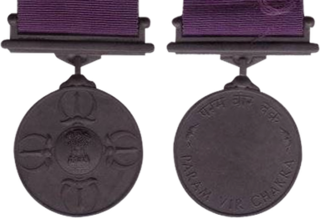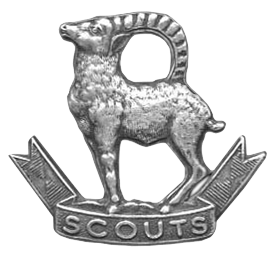
The Param Vir Chakra (PVC) is India's highest military decoration, awarded for displaying distinguished acts of valour during wartime. Param Vir Chakra translates as the "Chakra of the Ultimate Brave", and the award is granted for "most conspicuous bravery in the presence of the enemy". As of January 2018, the medal has been awarded 21 times, of which 14 were posthumous and 16 arose from actions in Indo-Pakistani conflicts. Of the 21 awardees, 20 have been from the Indian Army and one has been from the Indian Air Force. Major Somnath Sharma was the first recipient. A number of state governments of India as well as ministries of the central government provide allowances and rewards to recipients of the PVC.

The Jammu and Kashmir Rifles is an infantry regiment of the Indian Army. Its origins lay in the Jammu and Kashmir State Forces of the princely state of Jammu and Kashmir. After the accession of the state to the Indian Union in October 1947, the State Forces came under the command of the Indian Army. They remained in the original form until 1956 when Jammu and Kashmir Constituent Assembly effectively ratified the state's accession to India. Then the State Forces became the Jammu and Kashmir Regiment of the Indian Army. In 1963, the designation was changed to Jammu and Kashmir Rifles. After the conversion, the Ladakh Scouts came under the aegis of the Regiment, where it remained until raised as a separate Regiment in 2002.

The 11 Gorkha Rifles is a Gorkha regiment of the Indian Army that was re-raised after independence. The regiment consists of primarily the Kirant Tribes Rai, Limbu, Yakkha, Sunuwar of Eastern Nepal, Darjeeling, Kalimpong, Dooars of West Bengal, Sikkim and other parts of Northeast India. Though it is considered to be the youngest of the Gorkha regiments its lineage is as long as those of the 7th Gurkha Rifles and 10th Gurkha Rifles.

The Sikh Regiment is an infantry regiment of the Indian Army. Sikh regiment is the highest decorated regiment of the Indian Army and in 1979, the 1st battalion was the Commonwealth's most decorated battalion with 245 pre-independence and 82 post-independence gallantry awards, when it was transformed into the 4th battalion, Mechanised Infantry Regiment. The first battalion of the regiment was officially raised just before the partial annexation of the Sikh Empire on 1 August 1846, by the British East India Company. Currently, the Sikh Regimental Centre is located in Ramgarh Cantonment, Jharkhand. The Centre was earlier located in Meerut, Uttar Pradesh.

The Kumaon Regiment is one of the oldest infantry regiments of the Indian Army. The regiment traces its origins to the 18th century and has fought in every major campaign of the British Indian Army and the Indian Army, including the two world wars, and is one of the highest decorated regiments of the Indian Army.

The Madras Regiment is the oldest infantry regiment of the Indian Army, originating in the 1750s as a unit of the British East India Company. The regiment took part in numerous campaigns with the British Indian Army and the post-independence Indian Army.

Company Quartermaster Havildar Abdul Hamid Ansari, was an Indian Army soldier who was posthumously given India's highest military decoration, the Param Vir Chakra, for his actions during the Indo-Pakistani War of 1965.

Captain Bana SinghPVC is an Indian soldier and a recipient of the nation's highest gallantry award, the Param Vir Chakra. As a Naib Subedar in the Indian Army, he led the team that wrested control of the highest peak on the Siachen Glacier in Kashmir from Pakistani forces as part of Operation Rajiv. Following his success, India renamed the peak to Bana Post in his honour.

Subedar Major Sanjay Kumar PVC is a Junior Commissioned Officer in the Indian Army, and recipient of the Param Vir Chakra, India's highest military award.

The Garhwal Rifles, formerly known as the Royal Garhwal Rifles, are an infantry regiment of the Indian Army. It was originally raised in 1887 as the 39th (Garhwal) Regiment of the Bengal Army. It then became part of the British Indian Army, and after the Independence of India, it was incorporated into the Indian Army.

45 Cavalry is an armoured regiment in the Armoured Corps of the Indian Army. The regiment distinguished itself in operations during the 1971 Indo-Pakistan War winning one Maha Vir Chakra.

The 8th Gorkha Rifles is a Gorkha regiment of the Indian Army. It was raised in 1824 as part of the British East India Company and later transferred to the British Indian Army after the Indian Rebellion of 1857. The regiment served in World War I and World War II, before being one of the six Gurkha regiments transferred to the Indian Army after independence in 1947. Since then it has served in a number of conflicts including the Sino-Indian War of 1962 and the Indo-Pakistan wars of 1965 and 1971. Today the 8th Gorkha Rifles is one of the most celebrated regiments of the Indian Army, having received numerous citations for bravery in the field of battle, and even producing one of the two field marshals of India, Field Marshal Sam Manekshaw, of the Indian Army.

The Ladakh Scouts is an infantry regiment of the Indian Army, nicknamed as the "Snow Warriors" or "Snow Leopards". The regiment specializes in mountain warfare, and its primary role is to guard India's borders in the high altitudes of the Union Territory of Ladakh.

Naib Subedar Chuni Lal AC, VrC, SM was an Indian Army soldier of 8th battalion. The Jammu and Kashmir Light Infantry. He was born in Bhaderwah, and basically from Gandhari Paddar and lived in Bhara village with parents Shanker Dass and Shakuntala Devi in Doda district of Jammu. Decorated with Vir Chakra and Sena Medal (Gallantry), JC-593527, Lal was killed in action on 24 June 2007 in a militant flush-out operation in Kashmir's Kupwara sector. These militants, all of whom were also shot dead, were trying to cross the Line of Control (LoC) and enter Indian territory. The success of this militant flush-out operation, which claimed his life, earned him the highest peacetime military decoration awarded for valor, courageous action or self-sacrifice away from the battlefield, the Ashok Chakra. He is the highest decorated soldier of Indian Army of all time, honored with Sena Medal, Vir Chakra and Ashok Chakra.
Chunni Lal is a famous character of Bengali romance novel Devdas written by Sarat Chandra Chattopadhyay.
Operation Rajiv was the codename for an Indian Army operation that aimed to capture a high point along the Actual Ground Position Line (AGPL) on the Siachen Glacier in June 1987. Prior to this operation, the area had been under the control of Pakistani forces, who had established a post on the peak, designated Quaid Post. Following India's successful capture of the peak, the post was renamed to Bana Top after Naib Subedar Bana Singh, who led the operation. Since Operation Rajiv in 1987, India continues to hold this post, which lies just to the south of the strategic Bilafond La mountain pass, also controlled by India. Alongside the higher-altitude installations, India has also established posts on the slopes at lower heights in this sector.

Subedar Sujjan Singh Yadav, AC was an Indian Army Junior Commissioned Officer (JCO) with the 13th Battalion of the Kumaon Regiment. He was awarded the highest peace time gallantry award Ashoka Chakra posthumously for his action in Operation Rakshak in Kupwara, Jammu and Kashmir.
3 Medium Regiment is part of the Regiment of Artillery of the Indian Army.
Subedar Major and Honorary Captain Mahendra Singh, KC, SM is a decorated Indian Army Junior Commissioned Officer (JCO) of 9 Para SF. During an operation, he was paralysed on one side of his body.
94 Field Regiment is part of the Regiment of Artillery of the Indian Army.



















